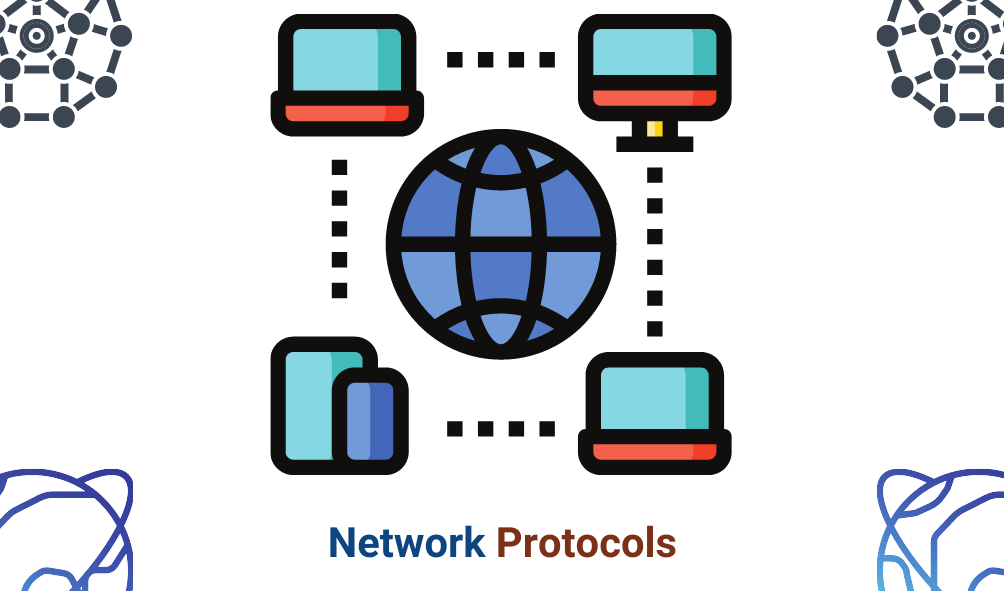Introduction: What are Network Protocols?
Network Protocols are a set of rules that decide how data is sent and received between devices over the Internet. They are like the way to decide how the devices communicate with each other over the internet when the devices are connected over a network.
Without network protocols, computers and other devices would not know how to communicate with each other. As a result, except for specialty networks built around a specific architecture, few networks would be able to function, and the internet as we know it wouldn't exist. Virtually all network end users rely on network protocols for connectivity.

Why Network Protocols Matter?
Standardisation: Ensures compatibility between various devices and systems.
Efficiency: Optimises data transfer and reduces congestion in networks.
Security: Provides encryption and authentication to protect data.
Reliability: Ensures accurate and error-free data transmission.
Network Management: Facilitates troubleshooting, monitoring, and maintenance.
Types of Network Protocols
Network protocols can be categorized based on their function:
Communication Protocols: These facilitate data transfer between devices.
IP (Internet Protocol): Handles addressing and routing of packets.
TCP (Transmission Control Protocol): Ensures reliable and ordered data transmission.
UDP (User Datagram Protocol): Provides faster, connectionless communication.
Security Protocols: These safeguard network communication.
SSL/TLS (Secure Sockets Layer / Transport Layer Security): Encrypts web traffic.
IPsec (Internet Protocol Security): Secures IP communication.
Network Management Protocols: These help monitor and manage networks.
SNMP (Simple Network Management Protocol): Manages network devices.
ICMP (Internet Control Message Protocol): Diagnoses network errors.
Application Layer Protocols: These enable user applications to interact with networks.
HTTP/HTTPS (Hypertext Transfer Protocol): Used for web browsing.
FTP (File Transfer Protocol): Facilitates file transfers.
SMTP/IMAP/POP3: Handles email communication.
OSI Model: A layered approach to networking
The Open Systems Interconnections (OSI) Model is the conceptual framework that ensures how the data is sent over the network to enable communication between devices. It consists of 7 layers, each with a specific function, ensuring efficient data transmission.
Physical Layer: This layer includes the physical equipment involved in the data transfer, such as the cables and switches. This is also the layer where the data gets converted into a bit stream, which is a string of 1s and 0s.
Examples: Ethernet cables, Wi-Fi signals, Bluetooth, USB.

Data Link Layer: This layer defines the format of the data that is to be transferred between two devices on the same network. The data link layer takes packets from the network layer and breaks them into smaller pieces called frames.
Protocols: Ethernet, ARP (Address Resolution Protocol), PPP (Point-to-Point Protocol).

Network Layer: This layer defines which physical path the data will take which is called routing. The network layer conducts routing between different network and then decides the most efficient path. The network layer breaks up segments from the transport layer into smaller units, called packets, on sender’s device, and reassembling these packets on the receiving device.
Protocols: IP (Internet Protocol), ICMP (Internet Control Message Protocol), IPsec.

Transport Layer: This layer transmits data using transmission protocols including TCP and UDP. This ensures reliable or fast delivery between devices. It handles segmentation, error detection, and flow control.
Protocols: TCP (Transmission Control Protocol), UDP (User Datagram Protocol).

Session Layer: This layer manages connections and the opening and closing of communications between the devices. The time between when the communication is opened and closed is known as the session.
Protocols: NetBIOS, RPC (Remote Procedure Call), PPTP.

Presentation Layer: This layer makes the data presentable for applications to consume. The presentation layer is responsible for translation, encryption and compression of data.
Protocols: SSL/TLS (Secure Sockets Layer / Transport Layer Security), JPEG, MPEG.

Application Layer: This layer accesses protocols used by applications to communicate data to end users. This is the only layer that directly interacts with data from the user.
Protocols: HTTP, FTP, SMTP, DNS.

How the OSI Model Works
When data is sent over a network, it moves from the Application layer (Layer 7) down to the Physical layer (Layer 1) on the sender’s side. At the receiving end, it moves from Layer 1 back up to Layer 7 to be interpreted by the application.
For example, when you send an email:
The Application layer (SMTP protocol) processes the email.
The Transport layer (TCP) ensures reliable delivery.
The Network layer (IP) handles addressing and routing.
The Data Link layer (Ethernet/Wi-Fi) enables device-to-device communication.
The Physical layer transmits the data as electrical signals or radio waves.
Conclusion
Network protocols are the foundation of communication in digital networks, while the OSI Model provides a structured approach to networking. Together, they enable reliable, secure, and efficient data transmission across the internet and enterprise networks. Understanding these concepts is essential for network engineers, IT professionals, and anyone involved in digital communication.
